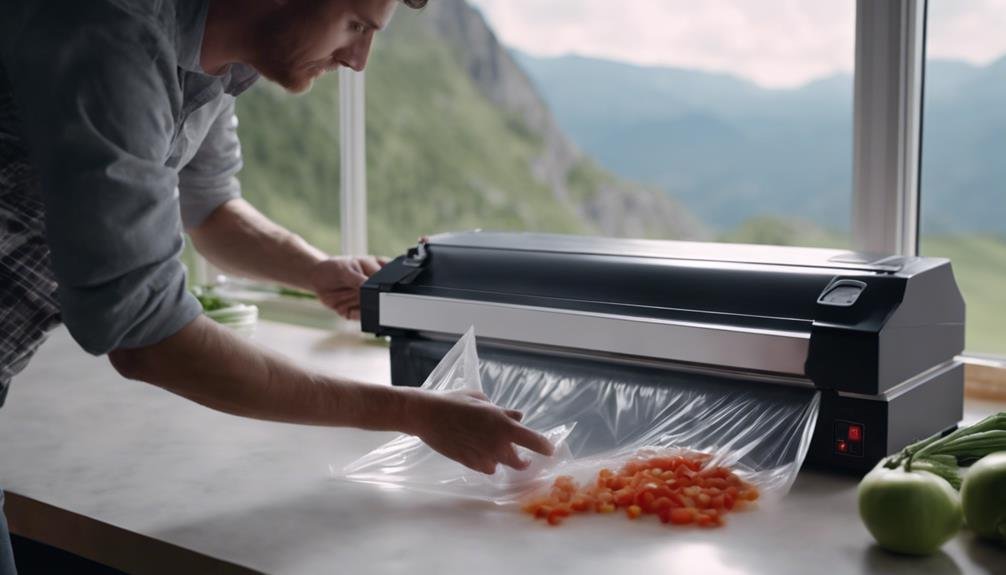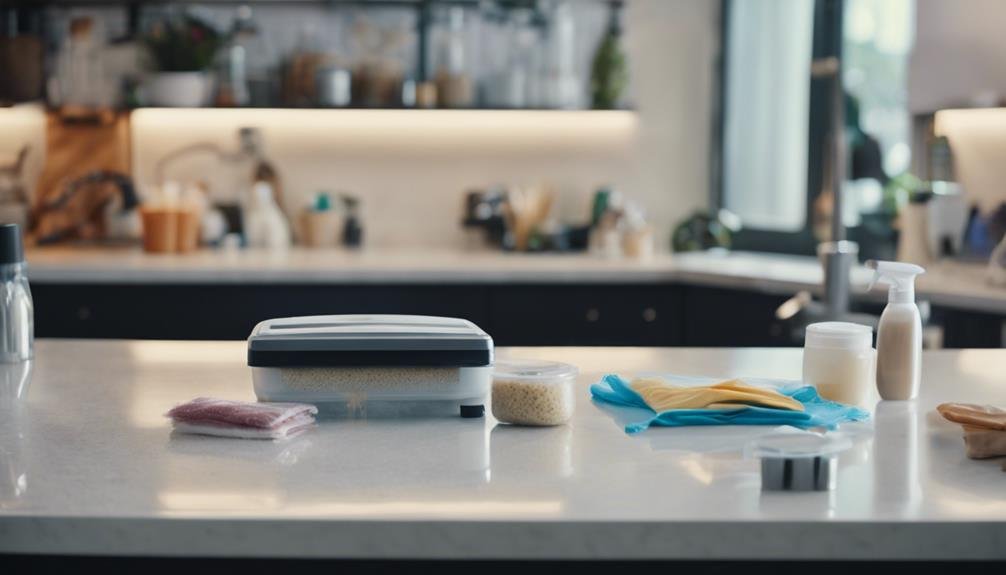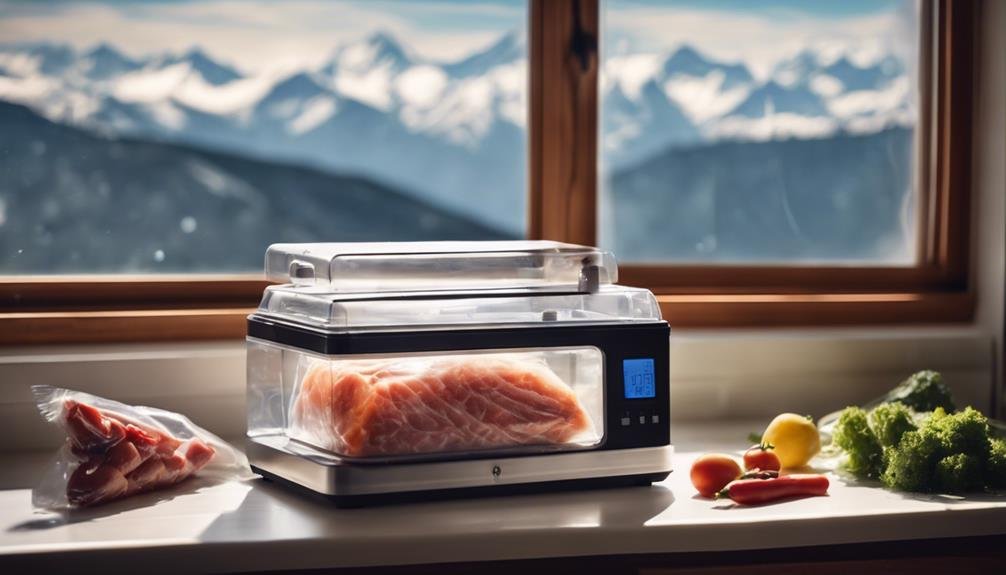Vacuum sealing at high altitudes can be tricky due to the lower atmospheric pressure. To combat this challenge, it's essential to adjust sealing times accordingly or upgrade to a more robust vacuum pump like an oil-sealed rotary vane or a turbomolecular pump. Ensuring the sealing system is airtight by checking for leaks and maintaining its components is crucial. Additionally, thorough cleaning of the sealing area and using top-quality vacuum sealer bags are recommended for optimal results. Consider investing in a chamber vacuum sealer for more effective sealing. By carefully monitoring and adjusting the vacuum levels, you can achieve secure and reliable seals even at high altitudes. For a deeper dive into specific strategies and tips, continue reading below.
Understanding High Altitude Challenges
High altitudes present unique challenges for vacuum sealing, primarily due to the reduced atmospheric pressure. When you're at a high altitude, the lower pressure can affect how well your vacuum sealer works. This happens because vacuum sealers rely on creating a pressure difference between the inside of the bag and the outside environment. At higher elevations, achieving that difference becomes harder.
You might notice that your vacuum sealer struggles to suck out all the air, leaving you with a less-than-perfect seal. This issue arises because the machine can't achieve the same level of vacuum as it would at sea level. To tackle this, you'll need to make some adjustments to your vacuum sealing settings. Increasing the sealing time or using a stronger vacuum pump can help compensate for the reduced atmospheric pressure.
Being aware of these high altitude challenges can make a big difference in your vacuum sealing success. By understanding the impact of altitude on the process, you can troubleshoot issues more effectively and optimize your vacuum sealing performance. This knowledge ensures that your food stays fresher for longer, even when you're living or traveling in high-altitude areas.
Choosing the Right Vacuum Pump
Selecting the right vacuum pump is essential for effective vacuum sealing at high altitudes. When you're working in these environments, the choice of pump can make or break your sealing process. Here's what you need to take into account:
- Oil-sealed rotary vane pumps: These are reliable and efficient at high altitudes, guaranteeing your vacuum sealing process runs smoothly.
- Dry screw pumps: Ideal for high altitudes because they're less affected by changes in atmospheric pressure, making them a dependable choice.
- Turbomolecular pumps: Used in specialized applications, these pumps maintain vacuum levels effectively even at elevated altitudes.
- Altitude impact: Always factor in how the altitude affects the vacuum pump's performance to secure consistent results.
Ensuring System Integrity

After selecting the appropriate vacuum pump, you must guarantee the system's integrity to maintain efficiency at high altitudes. First, it's important to check for leaks in your vacuum seal system. Even the smallest leak can compromise the vacuum seal, especially at high altitudes where the atmospheric pressure is lower. Regularly inspect all components to make sure they're properly sealed and free from scratches, as these can be potential sources of leaks.
Monitoring the vacuum pump is another essential step. Ensure it's operating efficiently and providing reliable performance. This involves checking for any unusual noises or signs of wear that might indicate a problem. A well-maintained pump will help maintain the necessary vacuum levels, making your sealing process more effective.
Proper maintenance, cleaning, and testing procedures are crucial for sustaining system integrity. Clean all parts thoroughly and inspect them regularly. Conduct routine tests to confirm that everything is working correctly. This proactive approach will help you identify and address any issues before they affect your vacuum seal's effectiveness.
Leak Detection Methods
Detecting leaks in your vacuum system is essential for maintaining peak performance at high altitudes. Even small leaks can have a notable impact on your vacuum pressure, especially when the air pressure is lower. To guarantee your system is leak-free, you should regularly test and inspect key components.
Here are four effective methods to detect leaks:
- Visual Inspection: Start by examining the acrylic pan surfaces, vacuum gauge, and air valve. Look for cracks, scratches, or any visible wear that might lead to leaks.
- Soap Bubble Test: Apply a soap solution to the suspected areas. If bubbles form, you've identified a leak.
- Vacuum Gauge Monitoring: Monitor the vacuum gauge for any unexpected drops in vacuum pressure. Sudden changes often indicate a leak.
- Outgassing Check: Be aware of outgassing from materials inside the vacuum chamber. This can resemble a leak, so ensure all components are properly outgassed before sealing.
Preparing Surfaces for Sealing

Thoroughly cleaning and drying the sealing area is vital to guarantee a proper seal at high altitudes. Since the lower air pressure at higher altitudes can complicate the vacuum sealing process, it's essential to start with a pristine surface. Any residue or moisture can interfere with creating a tight seal, causing air leaks that compromise the vacuum's effectiveness.
Begin by wiping down the area where you'll place the vacuum sealer bags. Use a clean, lint-free cloth to make sure no fibers are left behind. After cleaning, let the surface dry completely before proceeding. This step is particularly important when using vacuum techniques at higher altitudes, where even minor imperfections can lead to sealing issues.
Next, pay attention to the food packaging. Adjust the clearance or spacing between the food and the seal to accommodate the lower air pressure at higher altitudes. This little tweak can make a big difference in achieving a secure seal.
Lastly, make sure you're using high-quality vacuum sealer bags designed to withstand the effects of altitude. These bags are more durable and less likely to fail, ensuring that your vacuum-sealed items remain fresh for longer. Follow these steps, and you'll set yourself up for successful vacuum sealing, even in challenging high-altitude conditions.
Regular Maintenance Tips
Maintaining your vacuum sealer in top condition is essential for effective operation, especially at high altitudes. Regular maintenance helps guarantee that your equipment performs at its best, preventing potential issues that could arise from the unique conditions found at high elevations. Here are some key maintenance tips to keep your vacuum sealer running smoothly:
- Check and Monitor Vacuum Pump Oil: Regularly inspect the condition of the vacuum pump oil. High altitudes can cause the oil to degrade faster, so keep an eye out for any changes in oil quality. If you notice water accumulation, drain and refill the oil to maintain peak performance.
- Discharge Water from the Tank: Manually discharge any water from the vacuum sealer's tank. Water can interfere with the vacuum pump's operation, leading to inefficiencies or malfunctions.
- Inspect and Drain Cooler Water: Regularly inspect the cooler for condensed water and drain it as needed. This step helps maintain the sealer's efficiency and prevents potential damage to the system.
- Listen for Abnormal Noises: During operation, pay attention to any abnormal noises. Unusual sounds can indicate maintenance or repair needs, allowing you to address issues before they become serious problems.
Monitoring Chamber Pressure

Keeping a close eye on chamber pressure is essential when vacuum sealing at high altitudes. You need to monitor it closely because variations in atmospheric pressure can greatly impact the vacuum sealing process. A pressure gauge is your best friend here. It helps you track changes in the chamber pressure, making sure that everything stays within the best range.
High altitudes have lower atmospheric pressure, and this difference means you'll need to adjust your vacuum settings accordingly. If you don't, you might end up with improperly sealed items, which defeats the purpose of vacuum sealing. Regularly checking the pressure readings is crucial. It allows you to make real-time adjustments to maintain the correct pressure levels for effective sealing.
To get the best results, make it a habit to frequently check the chamber pressure. This practice helps you catch any deviations early, preventing potential issues. By staying vigilant and using your pressure gauge effectively, you can ensure that your vacuum sealing process goes smoothly, even at higher altitudes. Remember, keeping an eye on the chamber pressure isn't just a good practice—it's a necessity for successful vacuum sealing in varying atmospheric conditions.
Adjusting for Local Conditions
Adjusting your vacuum sealer settings for local conditions is crucial to guarantee effective sealing at high altitudes. The lower atmospheric pressure at high altitudes can impact the sealing process, so you need to tweak your approach for the best results.
- Use a Chamber Vacuum Sealer: These sealers are more reliable at high elevations due to their ability to handle pressure variations better than external models.
- Increase Clearance: Make sure there's more space between the food and the seal. This adjustment helps accommodate the effects of altitude on the vacuuming process.
- Monitor and Adjust Vacuum Levels: Regularly check the vacuum levels and make necessary adjustments based on your altitude. This step ensures that the pressure inside the chamber is adequate for a proper seal.
- Choose a Plateau Motor: Consider a vacuum sealer equipped with a plateau motor. These motors are designed to function reliably under varying conditions, making them ideal for high-altitude use.
Conclusion
You've mastered the basics of vacuum sealing at high altitudes, but here's where it gets truly intriguing. Imagine the thrill of achieving an airtight seal in the most challenging conditions. Think about the precision, the small tweaks that make all the difference. Are you ready to explore deeper into this skill and push your abilities to the next level? With the right knowledge and tools, the sky's not the limit—it's just the beginning. Immerse yourself and see what you can achieve!
